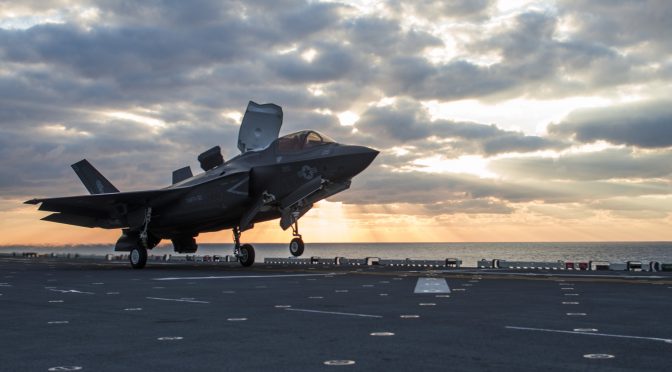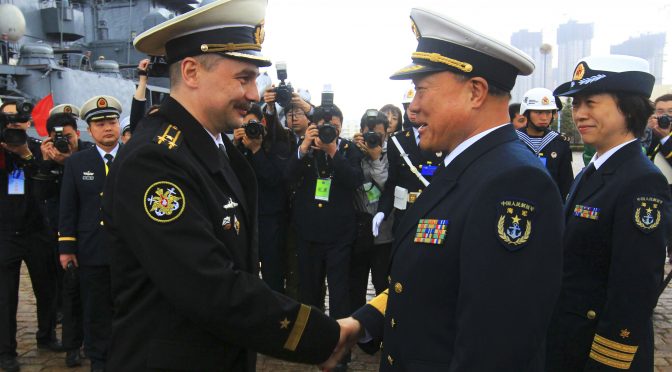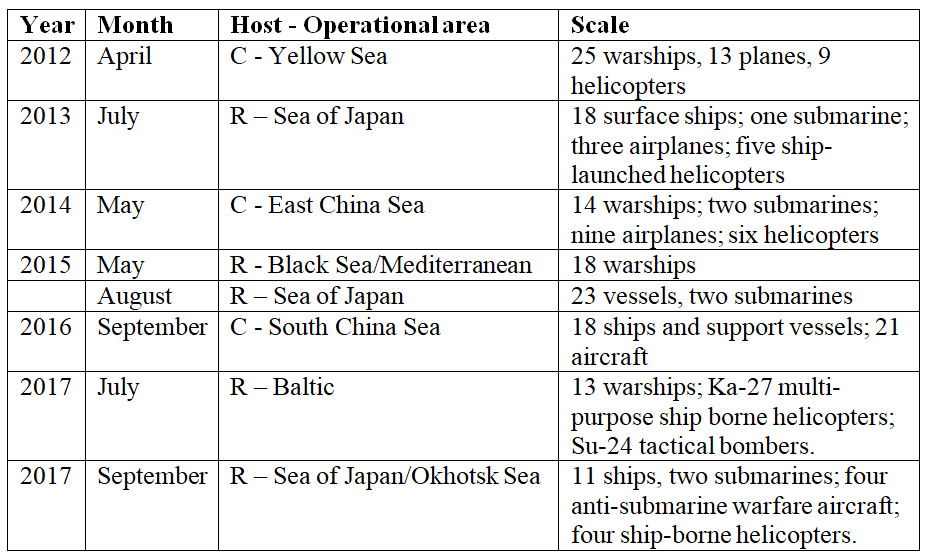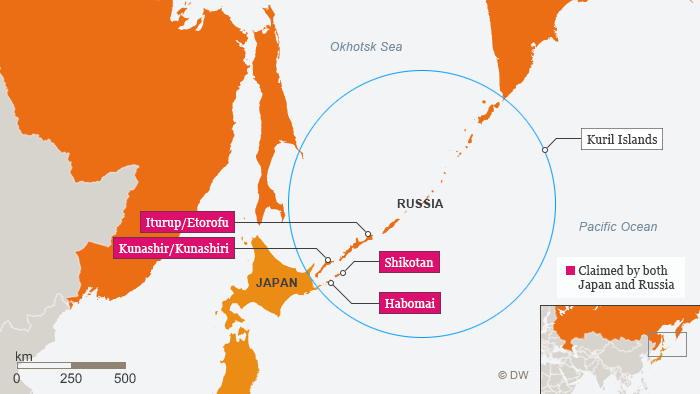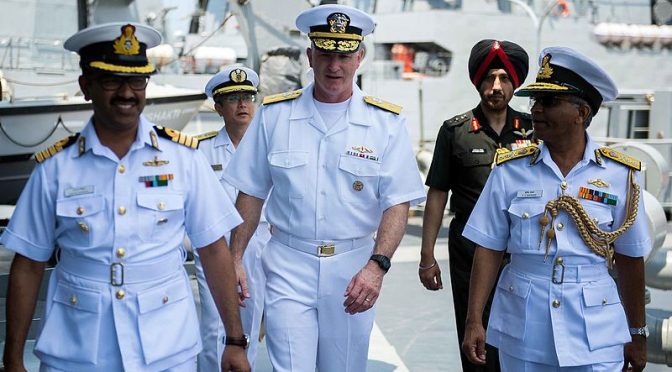Maritime Strategy for Great Power Competition Topic Week
By Harry Halem
Introduction – Maritime and Grand Strategy
During the third presidential debate of the 2012 election season, then-President Obama famously characterized the foreign policy of his Republican opponent, Mitt Romney, as decades out of date. When Romney identified Russia as the primary geopolitical foe of the U.S., Obama responded with “The 1980s are now calling to ask for their foreign policy back because the Cold War’s been over for 20 years.”
Six years later, candidate Romney’s prediction seems prescient, not antiquated. Russia and Iran now operate alongside one another in Syria, China continues to expand its maritime footprint in the South and East China Seas, and all the while North Korea’s nuclear arsenal holds America’s attention. Concurrently, the EU still struggles to respond to migrant flows from the Near East and North Africa, terrorist organizations persist despite ISIS’ destruction, and the world’s major powers struggle to counter transnational issues like piracy, international crime, and climate change.
Great power competition has clearly returned. But nontraditional issues have retained their relevance, with great powers using them as strategic facilitators in their quest to gain marginal advantages. In this international environment, the sea has retained its unbroken importance. The overwhelming majority of humankind’s physical trade is still transported on maritime highways, while the geography of contemporary global flashpoints, and the ambitions of great powers and nonstate actors, makes the sea central to international competition.
America’s sea services, therefore, require a new maritime strategy. One can understand maritime strategy as the relationship between naval and maritime power and a nation’s ultimate security objectives. This, in turn, stems from a grand strategy, a nation’s understanding of how to produce security from threat perception, safeguard its interests, and defend its honor. Crafting a new American maritime strategy thus requires a revitalized grand strategic paradigm, which entails a review of the nation’s enduring interests, and the specific threats it faces. From this broader paradigm, one can establish the relationship between a nation’s security and its maritime security, and outline a specific naval force structure.
The American Republic’s strategic objective remains preventing a hostile actor or coalition from dominating the Eurasian landmass. This requires fighting conflicts as far away from the American homeland as possible by establishing control of strategically vital regions in Eurasia. One can identify the illiberal entente of Russia, China, and Iran as the greatest adversaries of the U.S. The ultimate goal of this entente, and particularly of China, is to accumulate strategic nuances that can be used to crack America’s alliance structure or stage a coup de main against American forces.
One can identify three objectives for the sea services from this set of circumstances. First, American naval power must ensure access to specific narrow seas and maritime chokepoints. Second, the U.S. Navy (USN) and Marine Corps (USMC) must be able to deny America’s enemies their initial objectives in a broader conflict, with the goal of deterring or preventing a coup de main. Third, the sea services must field sufficient forward presence to preclude a fait accompli in various regions. One can identify a varied force structure to achieve these goals: a multi-Carrier Strike Group surface force optimized for sea control, a specific fleet of small surface combatants for use in the pre-conflict “grey zone,” a forward-deployed submarine force, and a USMC large enough to defend isolated outposts and mount large-scale counteroffensives. Absent such changes in force structure, America’s adversaries will be able to take advantage of critical capability gaps.
Grand Strategy – Manning the Distant Rampart
Politics, like any human interaction, is not strictly scientific. However, one can identify enduring interests for different international actors. For example, any power that wishes to dominate Europe must contest control of the Mediterranean. This was true of Rome, the Venetian Republic, the Habsburg and Ottoman Empires, Britain, the French Republic, and Imperial and Soviet Russia. Similarly, specific regional actors have enduring interests. One can identify an intelligible French territorial interest from the mid-15th century onward which, whether Valois, Bourbon, Bonapartist, or Republican, had an overwhelming interest in ensuring Central Europe’s political weakness, and dominating it if possible. Only two world wars and a sustained confrontation between superpowers mitigated this strategic objective.
Similarly, different “problems” exist in international politics. Geostrategists are familiar with Alfred Thayer Mahan’s “Problem of Asia” – the threat of Russia’s expansionist impulse and geographic position, or the potential power of a unified China, would pose to international stability. The “German Problem” is similarly enduring: a united Germany, absent clear military restraint, naturally jeopardizes European security because of the population and resources it can muster.
The American Republic faces what one could term the “Eurasian problem.” American safety and prosperity is directly tied to the Eurasian balance of power. Eurasia contains the majority of the world’s population and resources. Hence, the domination of Eurasia by a hostile power or coalition would ultimately pose a direct threat to American survival – such an actor or coalition would always retain the ability to deny America access to markets, or launch an offensive against the Western hemisphere. However, unlike similarly insular maritime powers like Japan and Britain, the United States lacks easy access to Eurasia by virtue of its distant geographic position. Even launching small-scale raids on the European coastline would require a notable exertion of American power if not for the positional advantages gained through alliances.
Waiting until conflicts reach the Western hemisphere jeopardizes American interests. It is unlikely that a hostile Eurasian power could actually conquer the territorial United States. However, a Eurasian power could come to dominate Latin America over time while attacking strategic points in the Caribbean and along the U.S. coastline, slowly eroding the position of the U.S., and forcing it to acquiesce to an unfavorable and likely illiberal international order. Nuclear weapons compound the issue. Mutually Assured Destruction would provide much less comfort against an anti-ballistic missile network and tactical nuclear arsenals distributed throughout the Western Pacific and Latin America.
Two strategic precepts flow from the Eurasian problem that the American Republic confronts. First, the U.S. must ensure a favorable Eurasian balance of power. Second, the best way to preserve this balance of power is by fighting wars and influencing events away from the Western Hemisphere. By maintaining overseas bases, partnering with regional powers, and fielding a powerful Navy, the U.S. can man what Professor Harold Rood termed in his 1967 prize-winning essay for Proceedings the “Distant Rampart.”
Just as France’s leaders have followed a consistent logic in their foreign policies despite changes in regime and ideology, so have the American Republic’s statesmen done the same. The American Revolution can be understood in part as an attempt to prevent the colonies’ interests from being overshadowed by those of Europe’s great powers during post-conflict settlements. The Monroe Doctrine began forward defense: preventing foreign meddling in the Western hemisphere precludes a campaign against America’s homeland. The belated American entry into both World Wars demonstrates strategy’s eventual triumph over ideology – American leaders could not accept German, either Imperial or Nazi, domination of Europe.
The unfortunate side effect of the American Republic’s ascendancy in the post-WWII era was the relative diminishment of allied European military power and global political networks born from colonial interests. Rather than simply supporting allies in key regions, during the Cold War the U.S. was forced to man the Distant Rampart itself, maintaining a permanent and prominent military presence in Europe and Asia, and committing to large-scale interventions in Korea and Vietnam.
Although the Soviet Empire collapsed in 1991, the Eurasian problem still persists. Advances in Artificial Intelligence are poised to revolutionize global economics and finance, but unless one can solve fundamental resource questions, maritime trade will remain central to the global economy, making hostile control of Eurasia an economic threat. Moreover, Eurasia’s resources comparative to the Americas ensure the persistence of the Eurasian problem.
Manning the Distant Rampart, then, must remain the core of American grand strategy. As such, maritime power is the most fundamental component of America’s national power because maritime power is what ultimately assures American access across the large oceans that separate it from the Eurasian landmass. Dominating Eurasia requires dominion over the large oceans that surround it and the narrow maritime chokepoints that connect key geographic regions. With such dominion, a would-be authoritarian hegemon can bully smaller states into submission by threatening to deny them access to regional trade, eroding their sovereignty through naval patrols in their territorial waters, and staging amphibious assaults upon their territory. Eurasia’s narrow seas also include maritime chokepoints that constrain nearly all seaborne movement – controlling even one of these chokepoints gives the dominating power the ability to manipulate the global economy, and deny other powers secure lines of communication while facilitating the transfer of forces between theaters. Maritime strategy, therefore, is a significant part of American grand strategy, as Eurasia’s proximate maritime features and chokepoints have always been central areas of contestation in great power competition.
Threats – the Illiberal Entente and its Wildcards
Delineating specific roles for the sea services requires a review of the specific challengers the American Republic faces, along with the “wildcards” that said challengers can employ or benefit from, particularly terrorism and non-state actors.
Nearly 111 years ago, Britain, France, and Russia cemented the mutual political and strategic understanding that is termed the Triple Entente. While each partner was an erstwhile rival or enemy of the other two, all three shared an interest in containing Imperial German power. One can see a similar arrangement developing between three aspiring hegemons today – China, Russia, and Iran. Each has either openly facilitated or tacitly acquiesced to the aims of the other two, in the belief that destabilizing American power elsewhere will enable its own regional objectives.
China poses the most obvious threat. It has the world’s largest population (1.4 billion) and either its largest ($21-23 trillion PPP) or second-largest ($11-12 trillion nominal) GDP. Scaling for personnel costs and adjusting the purchasing power of U.S. and Chinese budgets, China may spend roughly the same and possibly more than the U.S. on weapons systems, military operations, and training exercises.
China’s contemporary military is the culmination of four decades of development and reform. The PLA is the largest active military in the world. Its Navy is one of six that operates both a fixed-wing aircraft carrier and a nuclear-powered ballistic missile submarine. Its Air Force operates the world’s third largest combat aircraft fleet, and is one of three to field strategic bombers. Moreover, its Navy is scheduled to possibly outstrip America’s in size by 2020.
China’s internal system rests upon contradictory premises. Selective liberalization and capitalization are in tension with socio-political uniformity. Since Deng Xiaoping’s victory over the Gang of Four, the Chinese Communist Party (CCP) has restrained itself from overt, society-wide ideological engineering. Rather than pursuing a socialist utopia, the PRC’s social contract requires the continual increase of living standards, particularly for the urban middle class, in return for acquiescence to the regime’s social control. Such a social contract is not fully legitimate – a fact that helps explain the CCP’s fixation on Taiwan, an economically vibrant democracy that demonstrates an alternative developmental path.
One can link this fixation on legitimacy with the CCP’s ideational aims. Chinese rhetoric about its “century of humiliation” must be taken seriously in understanding China’s perspective. As the preeminent Western power, the lynchpin of the contemporary international economic order, and with its network of Pacific bases and a blue-water Navy, America is China’s obvious rival. Many elements of China’s economy are dependent on seaborne commerce, such as how China’s economy requires natural resources for production and its population needs more energy than China’s domestic deposits provide.
Hence, China has embarked upon a campaign of hedging against U.S. offensive action and global economic shock, the two events that can disrupt Chinese growth. In maritime terms, this is best expressed in its South China Sea (SCS) and East China Sea (ECS) aggression. The majority of China’s imports pass through these waters, making hostile control of them in war a mortal threat to Chinese ambitions and stability. Additionally, control of the SCS and ECS allows China to isolate Taiwan and cut off energy flows to Japan, breaking up the U.S. regional alliance structure. On land, China is attempting to acquire resources at the point of extraction, especially in Africa and Central Asia. Beijing’s One Belt One Road initiative seems grandiose and ill-fated until one identifies it as a component of Chinese hedging. Rather than attempting to compete with American maritime advantages overland, China could be attempting to create a windpipe to relieve itself during a major crisis. Concurrently, China has expanded its maritime trade fleet, an asset that ensures energy and other imports during the next international economic contraction. Finally, Beijing’s hedge includes the ultimate goal of transforming China’s economy, to ensure the rising living standards its urban middle class demands. Chinese encroachments into Latin American markets facilitate this objective, while also offering it access into the geopolitical backyard of the U.S.
While China operates largely independently in the Pacific, Russia and Iran have intertwined objectives in the Near East and Europe, making it reasonable to address both powers simultaneously.
Putin’s Russia lacks the USSR’s military capabilities, but the laws of geopolitics still apply. While Russia’s military weakness relative to China has diminished its role in Asia’s balance of power, the Russian problem remains relevant for Europe and the Near East. Russia’s overarching strategic objective, whether Imperial, Soviet, or Putinist, has been securing itself from European invasion. European nations have been united twice under an anti-Russian coalition – in both instances, Russia survived an invasion attempt, but only after immense loss of life and expenditure of resources. Controlling Eastern Europe gives Russia a buffer against potential aggression, while establishing itself as Europe’s preeminent power offers long-term security. This combines with Russia’s ideological impulses, which Imperial and Soviet Russia both shared. Russia’s self-image demands respect, whether as the Roman Empire’s successor, leader of international Marxism, or simply Europe’s foremost state.
Considering Russia’s diminished power position, obtaining Eastern Europe as a buffer and expelling America from the European continent requires creative strategy. Rather than physically removing the U.S., Russia is attempting to “crack” NATO by attacking its members’ domestic institutions, likely as a prelude to crisis generation. The Eastern Mediterranean and Black Sea are central to this goal – control of both allows Russia to dominate the Balkans and pressure Europe’s “soft underbelly.”
Russia’s objectives in the Eastern Mediterranean and Black Sea mesh with Iran’s regional ambitions. One should not underestimate the religious animus that drives the Iranian regime. The Islamic Republic’s political structure, despite its electoral obfuscation, heavily centralizes control in the clerical class and the IRGC. Locked in religious competition with Israel and sectarian competition with Saudi Arabia, the Iranian regime’s “governance of the jurist” engenders an aggressive, anti-Western foreign policy. Additionally, the Iranian people still remember the Anglo-American engineered deposition of Mohammed Mossadeq in 1953, adding distrust to Iranian avarice. Even more apparent than Iran’s ideological goals are its actions. Tehran has manufactured a corridor from Iran’s borders to the Eastern Mediterranean through proxies in Iraq and Syria. Despite its nuclear arsenal, Israel’s population precludes an actual offensive campaign against Iran, while Saudi Arabia, despite Mohammed Bin Salman’s reforms, remains corrupt and internally weak. If Israel or Saudi Arabia could subjugate Iran, one of the two would have done so already, rather than allowing the Islamic Republic to continue increasing its power. The Iran-Iraq War demonstrated the true strength of Iran’s society. Israel and Saudi Arabia, therefore, seek a reasonable accommodation, while Iran desires domination.
To facilitate their mutual aims, Tehran and Moscow have entered into an increasingly public partnership. Russia’s increased presence in the Eastern Mediterranean and support of the Assad regime occurs in tandem with Iran’s increasing control over Iraq, and its support for Hezbollah. Russia lacks a territorial interest in the Near East, while Iran’s primary rivals are land-based. Hence, the two powers cooperate to achieve their joint goals, with Russian weapons finding their way to Iranian proxies, and Iranian special forces working alongside Russian troops. Recent news of a Russo-Israeli agreement on Iran’s withdrawal from southern Syria does not change this relationship. Russia requires Iran’s partnership, absent increased Turkish stability or a literal revolution in Saudi Arabia, while Iran can still support Hezbollah, even if its forces are not stationed on Israel’s northern border.
Not only do the actions of each of the illiberal entente’s members support others’ positions – all three partners use strategic wildcards to expand their power.
Iran’s relationship with Russia has already been explicated. Less obvious is its relationship with China. Aside from the military relationship between Tehran and Beijing, Iran can influence the Strait of Hormuz, an important strategic chokepoint for China especially. This past April, India and China imported nearly half of Iran’s oil production. Oil travelling to China from Iran by water must pass through the Strait of Hormuz, off Iran’s coastline, and the Strait of Malacca, on the SCS’ southern rim. Even if China gains control of the SCS, the U.S. Navy could exert distant pressure in the Indian Ocean, denying China-bound ships the opportunity to even reach the Strait of Malacca and where directly blockading the Strait of Malacca would be economically catastrophic.
China and Iran are developing the mutual tools and positions to respond to such a move. Iranian long-range missiles like the Shahab-3, with its 2000-kilometer range, can reach a longitudinal line running from the Horn of Africa to the Indian coast. If the road-mobile weapon is based in Houthi-controlled Yemeni territory, one could envision an even greater area of coverage. Concurrently, China now holds two ports in the Indian Ocean: Gwadar, on the Pakistani coast, and Colombo, in Sri Lanka. Neither location is militarized today, but both could become focal points for Chinese power projection in the Indian Ocean in the future. Even absent the hardening that would make these ports tenable in a major conflict, China can still use them to escort China-bound shipping in a “grey zone” scenario as described above. China lacks regular Mediterranean presence, but Iranian and Russian acquiescence to China’s Eastern Mediterranean economic expansion indicates similarly overlapping interests. One could envision the Greek port of Piraeus becoming a shared location for the illiberal entente’s members
China, Russia, and Iran also benefit from strategic wildcards that can disrupt the status quo, and provide cover for expansion. ISIS posed an undeniable security threat to Iran and Russia. But it is also clear that, without Iraqi state weakness, Iran’s project to create a chain of proxy or allied states spanning the Near East would be much further from completion. Russia would have lacked cover to expand its reach into the Eastern Mediterranean and threaten Europe’s underbelly without the rebel and jihadist threat against the Assad regime. Similarly, the PLA Navy would not be able to deploy as easily to the Indian Ocean without the cover of antipiracy operations. China’s current antipiracy Indian Ocean presence consists of two frigates and 700 Special Operations Forces and other soldiers. But if China’s presence in Africa, anchored in Djibouti, expands, this could turn into a larger, more permanent force. One should note that a Sino-Iranian response to American interdiction of China-bound shipping in the Indian Ocean would likely involve the forces engaged in antipiracy operations off the Horn of Africa.
None of these adversaries have the immediate goal of war with the United States. However, all three powers have the potential to execute faits accomplis – quick, decisive actions that cannot be responded to absent general escalation. Russia maintains overwhelming relative superiority in the Baltics and Ukraine. Putin could one day elect to quickly connect St. Petersburg to Kaliningrad, or drive further west in Ukraine. China outnumbers and outclasses the Philippines and Vietnam in the SCS. If Chinese violations of Vietnamese or Philippine fishing waters, or a repeat of the Hai Yang Shi You 981 standoff, prompt a strong militarized response, the PLAN and PLAAF would enjoy steep superiority over their regional counterparts. Vietnam would fare better in a full-scale confrontation, but China could still obtain the more limited objective of neutralizing the Vietnamese Navy by drawing it out into a lopsided engagement. In each of these situations, the U.S. will be faced with the choice between escalation, and the potential of general war between nuclear-armed powers, or acquiescence to adversarial expansion and intimidation, and the erosion of its strategic position.
Moreover, an ultimate goal of China, may be to stage a coup de main against American forces in the Pacific. China’s long-range missiles would isolate America’s Pacific bases from one another and American forces from their allied counterparts, while long-range strike aircraft and amphibious units would overwhelm remaining outposts, and leave China with a free hand to neutralize Taiwan. Bursting through a cordon of the First and Second Island Chains, PLAN submarines could attempt to tie down U.S. follow-on forces by attacking naval bases at Pearl Harbor, Kitsap, and San Diego. Even more unconventionally, a great power adversary could smuggle weapons of mass destruction into major American cities using clandestine naval power, as ML Cavanaugh suggests in his provocative Modern War Institute piece, and hold the U.S. population hostage through threat of an unpreventable nuclear strike. Accumulating nuanced advantages through repeated faits accomplis can facilitate ultimate objectives.
Manning the Distant Rampart – Maritime Strategy and Force Structure
The clearly maritime nature of contemporary great power competition, along with the specifics of the illiberal entente’s objectives and capabilities, necessitates a specific maritime strategy. The USN should be tasked with three major missions: maintaining control of certain strategic chokepoints, the prevention of a coup de main by manning specific Distant Ramparts, and the prevention of faits accomplis.
First, the sea services must control specific international chokepoints which correspond to the narrow seas previously discussed. Most important to this strategy is control of the Strait of Hormuz, Strait of Malacca, and the Eastern Mediterranean Basin. Control of these three chokepoints enables a far blockade/interdiction strategy critical to victory in a long-term conflict. Control of the Eastern Mediterranean hems in Russia from the South, facilitates operations against Iranian expansion in the Near East, and shortens transit time between the Atlantic and the Pacific. Control of the Strait of Hormuz and Western Indian Ocean enables a far blockade or interdiction operation against China, and provides critical screening for forces moving between the Far East and Europe. Finally, control of the Strait of Malacca and the Indonesian Throughflow, while not a foolproof method to prevent Chinese submarine leakage into the Indian Ocean, would at least make it more difficult for PLA Navy surface combatants to operate in this maritime space. Moreover, were China to militarize Colombo and Gwadar, and create a major facility in Djibouti, American and Allied forces would likely be able to prevent their relief and neutralize their combat efficacy.
Second, the USN and USMC must maintain overwhelming force superiority at critical sections of the Distant Rampart. In particular, the Ryukyu Islands, Indochinese coastline, and Persian Gulf must be unimpeachably secure. Crushing smaller adversaries like the Philippines and, depending on the conflict, Vietnam, could be executed before the arrival of American follow-on forces. A Taiwanese fait accompli is also possible, particularly if China struck after eliminating Vietnam or the Philippines. However, if China were not to secure a quick victory, it would need to isolate Taiwan from external supply lines and possible vectors of foreign intervention. This involves cutting through the Ryukyu Islands and Luzon in a pincer movement. Similarly, a quick descent upon the Strait of Malacca could require neutralizing Vietnam as an adversary – forces operating from Da Nang and Hai Phong would directly threaten the Southern Seas Fleet’s bases on Hainan Island and in Zhanjing. Ensuring American strength at each of these points would make the risk of these decisive actions much greater. If China cannot neutralize Taiwan with an overwhelming first strike, and if reinforcing CSGs and submarines operate behind a nest of island-based missile defenses, China will need to actually fight for the First Island Chain, rather than gaining it as a launchpad for further operations. If a Chinese move against Malacca requires eliminating an American-aligned Vietnam that can stall an offensive, the possibility of a quick, decisive strike spiraling into a broader war increases. And if America holds force superiority at key strategic points, this broader war looks increasingly less attractive for China. A similar concept applies in the Persian Gulf. A quick Iranian strike against Saudi Arabia or an attempt to control the Strait of Hormuz would be much less attractive if American forces in the Persian Gulf could intercept incoming Iranian missiles, sink the inevitable swarm of fast attack craft and missile boats, and eliminate the Iranian naval command at Bandar Abbas. Maintaining superiority at critical points on the Distant Rampart ensures that America’s adversaries will need to seriously consider the implications of full-scale and long-term war, rather than being tempted to strike quickly and decisively.
Third, the sea services, and the Navy in particular, must guard against smaller-scale faits accomplis from America’s adversaries by maintaining long-term and sufficient presence and combat power in the narrow seas, namely the SCS, ECS, Baltic, and Eastern Mediterranean. The specific force structure in the first three differs from that in the last. The SCS, ECS, and Baltic are potential “hot zones,” in which China or Russia could stage a quick strike against an American ally or U.S. forces. For long-term combat power, submarines are more important in these areas than surface combatants – although small surface combatants used as a tripwire, and to engage in grey zone operations, are relevant. By contrast, Russia’s aim of cracking NATO involves applying coercive naval and maritime pressure to Southern Europe and, potentially, Israel. Particularly in the Eastern Mediterranean, land-based airpower can prove decisive in preserving sea control, as Britain’s experience during the Second World War demonstrated. Thus, the USN’s Eastern Mediterranean role must be to outmuscle Russian warships, serving as a visible marker of American interest in, and commitment to, a favorable regional balance of power.
A specific force structure and distribution descends from this strategy. The two major chokepoints that the U.S. must control – the Strait of Hormuz and Strait of Malacca – require frequent carrier coverage, or at a minimum, a large, visible surface presence. In addition, the USN must provide a capable battle force ready to deploy to Asiatic waters, which likely includes two on-station CSGs at any time. Presuming contemporary operational tempo during peacetime, this necessitates an expansion of the U.S. carrier fleet to 15 ships from its present 11. Despite their age, the Navy could consider bringing the USS Enterprise and John F Kennedy out of retirement, at least until the mid-2020s, when CVN-80 will be commissioned. With four surface combatants and one submarine per CSG, the Navy will need to dedicate 20 surface combatants and five SSNs exclusively to maintaining these permanent formations. That is absent the surface action groups necessary to operate a far blockade. The Future Surface Combatant’s development offers a significant opportunity in this regard: developing a family of warships intended to operate as a cohesive, networked whole in blockade operations would benefit America’s long-term strategy.
Preventing faits accomplis requires a similarly significant force restructuring. The basis of this deterrence force should be the four Ohio-class submarines the USN has modified to carry cruise missiles, operating alongside Surface Action Groups (this makes eight more deployed DDG-51s, DDG-1000s, or CG-47s). Such formations will be particularly important in the Baltics, SCS, and ECS, environments in which America’s adversaries could contest access in crisis situations. The SSGNs will be able to avoid enemy detection, and inflict substantial punishment on advancing forces and their supporting infrastructure with their 154 cruise missiles. However, the U.S. must consider revising longstanding biases, and forward-deploying small surface combatants optimized for lethality, rather than emphasizing survivability and defensive armament. Conventionally-powered attack submarines may also be a part of such a force, either directly in the U.S. fleet, or operated by American allies with weaker military capabilities.
Most importantly, preventing a coup de main requires a radical overhaul of the USN’s and USMC’s present operational outlook. While the far blockade is invaluable to winning a major great power war, it is unlikely to deter one. Short, decisive actions that transform the regional balance of forces are unlikely to be deterred by long-term punishment strategies, of which the far blockade is an example. The case of Germany in 1914 is illustrative. British strategy was premised on maintaining the far blockade against Germany, and in conjunction slowly grinding down Germany’s military positions on the European continent. The strategy worked, but only after 1.1 million British and Imperial lives were lost. If Britain had attempted to deny Germany its immediate objectives in 1914, and threatened to deploy 30 or more divisions in support of France at the outbreak of hostilities, the already anxious Moltke the Younger may have objected to the Schlieffen Plan in its totality.
Similarly, denying China its objectives in the Pacific requires ensuring that Taiwan remains defended and supplied despite an overwhelming initial Chinese offensive. Neutralizing Taiwan is essential for China’s long-term war objectives in a protracted and wide-scale conflict. If the island remains functionally independent, it could act as a strategic salient for hostile forces, and a staging point for attacks against Chinese shipping and naval units. The two-CSG battle force proposed previously would help protect Taiwan from China’s initial offensive. However, the USMC must also fortify the islands that provide access to Taiwan, namely the Ryukyus and the north of the Philippine archipelago. This not only entails an expansion of the USMC, but also a modification of its role. Marines fortifying these islands must field their own long-range anti-ship and anti-air missiles, while the Marine air units deployed would be focused upon air defense and sea control, rather than ground attack.
The exact size of such a fleet and Marine Corps would fluctuate depending upon specific operational choices. However, one can expect the USN would break 350 ships, while the USMC would expand to 190,000-200,000 men.
Conclusion
Such a force expansion would be costly, but is miniscule compared to the price of fighting a major war unprepared. Manning the Distant Rampart is an expensive process, even with allies to shoulder the load. But abandoning it, as empires from Rome onward have learned, is even more dangerous. By refocusing U.S. maritime strategy on forward defense and offensive action, one can hope for, if not the realization of American security goals, then at least the right general approach to the Republic’s challenges.
Harry Halem is an undergraduate at the University of St Andrews studying International Relations and Philosophy. He welcomes your comments at hh66@st-andrews.ac.uk.
Featured Image: EAST CHINA SEA (March 11, 2018) An F-35B launches off the flight deck of the amphibious assault ship USS Wasp (LHD 1) as part of a routine patrol in the Indo-Pacific region. Pilots with the “Green Knights” of Marine Fighter Attack Squadron 121 (VMFA-121), assigned under the Okinawa-based 31st Marine Expeditionary Unit, are scheduled to conduct a series of qualification flights on Wasp over a multi-day period. (U.S. Navy photo by Mass Communication Specialist 3rd Class Levingston Lewis/Released)

